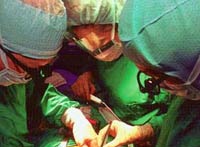This was the first time that local anesthesia had ever been used in major surgery. Dr. Kane believed that local anesthesia was safer than putting a patient completely to sleep. Most of his colleagues agreed with him in principle, but they wanted to see first if it would actually work.
So Dr. Kane searched for a volunteer, a patient who would be willing to undergo surgery while under local anesthesia. It wasn't easy to find one. Most people are squeamish at the thought of being awake during their own surgery. Others are fearful that the anesthesia might wear off too soon.
Finally, though, Dr. Kane found a volunteer. On Tuesday morning, February 15th, the operation began. The patient was prepped and wheeled into the operating room. A local anesthetic was applied. As Dr. Kane had done thousands of times before, he cut open the tissues and removed the appendix. The patient had only minor discomfort, recovered quickly, and was dismissed two days later.
Dr. Kane had proven his theory. Thanks to the willingness of a brave volunteer, Dr. Kane demonstrated that local anesthesia was an alternative - even a preferred alternative.
But I said there were two facts that made this surgery unusual. I've told you the first: the use of local anesthesia. The second unusual thing was the patient - the patient was Dr. Kane. You see, in order to prove his point, Dr. Kane operated on himself. The doctor became a patient in order to convince the patients to trust the doctor.
Because God's children are human beings-made of flesh and blood-Jesus also became flesh and blood by being born in human form. ... Since he himself has gone through suffering and temptation, he is able to help us when we are being tempted. (Hebrews 2:14-18 NLT)











Comments
Have thoughts on this article? Leave a comment